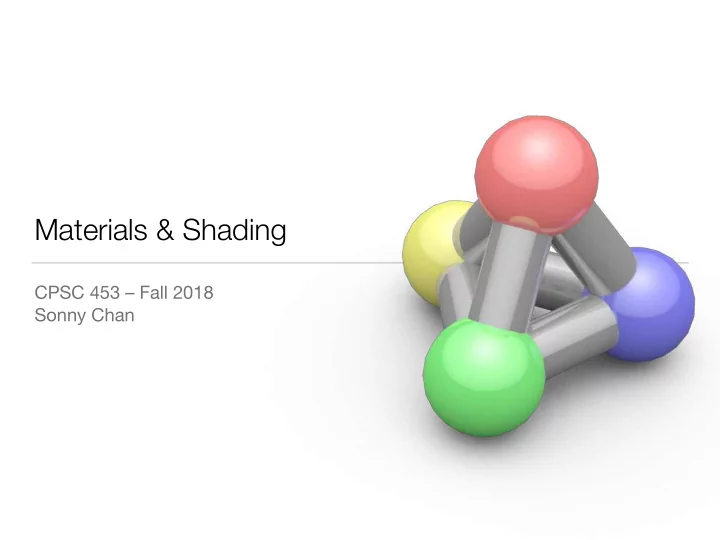

Materials & Shading CPSC 453 – Fall 2018 Sonny Chan
Materials Rendered by Unreal Engine
The appearance of a material is determined by the manner in which light is reflected from it, or transmitted through it.
What is the most basic material property?
Colour: Spectral Reflectance Curves [from scratchapixel.com]
But not the only factor! RenderMan PxrLM
Let’s take a look at some real world materials
Hand with Reflecting Sphere (Self-Portrait) M.C. Escher, 1935
Ideal Specular Reflections r = d − 2( d · ˆ n )ˆ n Trace another ray, as if you were looking from underneath.
Real surfaces are not perfectly specular!
Real surfaces are not perfectly specular!
Mixed Specular Reflections r = d − 2( d · ˆ n )ˆ n Add fraction of ray’s light with to surface material colour.
But wait a minute… dielectric (non-conductor) metallic (conductor) What’s the difference?
Metallic Specular Reflections r = d − 2( d · ˆ n )ˆ n Multiply reflected ray’s light with the surface material colour.
A Glass Marble What do we do with this material?
Snell’s Law • Ratio of sines of angles is equal to ratio of velocities: sin θ sin φ = v = n t v t n
n Material 1.0001 air 1.333 water Index of Refraction 1.47 olive oil of some common materials 1.52 crown glass 1.62 flint glass 2.15 cubic zirconia 2.42 diamond
Ray Tracing Refraction n sin θ = n t sin φ cos 2 φ = 1 − n 2 (1 − cos 2 θ ) n 2 t t = n ( d + ˆ n cos θ ) − ˆ n cos φ n t
A Diffuse Reflector M.C. Escher, 1946
Three Spheres II M.C. Escher, 1946
Properties of Diffuse Reflectors
Diffuse Reflection • Brightness dependent only on the direction of incident light • View direction has no effect on appearance • Lambert’s cosine law: n · ˆ c ∝ ˆ l n · ˆ c = c r c l max(0 , ˆ l )
Specular Highlights A Heuristic Approximation
Moonlight Reflection What do you see in this picture?
Plastic, Magnified [image from gelsight.com]
Microfacet Geometry Model [images from Real-Time Rendering , A K Peters, 2008]
Phong Lighting Model r = − l + 2( l · ˆ n )ˆ n r ) p c = c l max(0 , ˆ e · ˆ
Blinn-Phong Lighting Model e + l ˆ h = || e + l || c = c l max(0 , ˆ n ) p h · ˆ
p = 1 The Phong Exponent y = cos p θ p = 64
Phong Highlights
Summary: Types of Surface Reflectance • Ideal specular (mirror) reflection law - • Ideal diffuse (matte) Lambert’s law - • Specular (glossy) directional diffuse -
What about ambient light?
Indirect Lighting Material reflection works both ways!
Global Illumination indirect direct combined Global illumination is really hard and expensive to compute!
Ambient Light Approximated by a constant light source that represents the average indirect light energy in the scene. c = c r c a
Our final heuristic shading equation… • with ambient, diffuse, and specular terms: ⌘ p ⇣ ⌘ ⇣ n · ˆ ˆ c = c r c a + c l max(0 , ˆ l ) + c l c p h · ˆ n c r is reflectance (diffuse) colour of material • c p is specular colour of material • p is Phong exponent, or shininess of material • c l is light source intensity (colour) • c a is ambient light intensity (colour) •
Things to Remember • The appearance of a material is determined by the manner in which light is reflected from it • The Phong lighting equation approximates material colour, diffuse and specular reflection, and ambient light • Ideal specular reflection and refraction are relatively easy to achieve with ray tracing
Recommend
More recommend